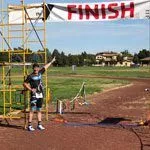Understanding Your 80/20 Core Strength Plan
Core strength is important for all endurance athletes. Strengthening the muscles in your body’s midsection will help you swim with greater tautness and less drag, cycle with less low-back discomfort, and run with better posture and less energy waste, among other benefits. There’s a reason elite endurance athletes make time for core strength training, and you don’t have to be a pro to get the same benefits.
Designed by A.J. Greg, MS, DC, CSCS, our 80/20 Core Strength Plans are intended to complement our endurance plans in a practical, flexible way. There are nine plans in total, ranging from 9 to 23 weeks in length. The idea is to select a plan that matches the length of your chosen endurance plan and layer it on top. For example, suppose you’re planning to start our Level 1 Olympic Triathlon Plan, which is 16 weeks in length. In this case you’ll want to select our 16-week Core Strength Plan and align the start date with the start date of your triathlon plan. The following table shows which endurance plans are compatible with each Core Strength Plan.
| Core Strength Plan | Compatible with . . . |
|---|---|
| 9 Weeks | Running Plans
5K Level 0 5K Level 1 5K Level 2 5K Level 3
Cycling Plans 20K Time Trial/FTP Boost Level 0 20K Time Trial/FTP Boost Level 1 20K Time Trial/FTP Boost Level 2 20K Time Trial/FTP Boost Level 3 |
| 12 Weeks | Running Plans
10K Level 0 10K Level 1 10K Level 2 10K Level 3 High School Cross Country Level 0 High School Cross Country Level 1 High School Cross Country Level 2 High School Cross Country Level 3 Run Maintenance Level 0 Run Maintenance Level 1 Run Maintenance Level 2 Run Maintenance Level 3
Triathlon Plans Sprint Triathlon Level 0 Triathlon Maintenance
Cycling Plans 40K Time Trial/FTP Boost Level 0 40K Time Trial/FTP Boost Level 1 40K Time Trial/FTP Boost Level 2 40K Time Trial/FTP Boost Level 3 Gran Fondo Short Course Level 0 Gran Fondo Short Course Level 1 Gran Fondo Short Course Level 2 Gran Fondo Short Course Level 3 Gravel Race Short Course Level 0 Gravel Race Short Course Level 1 Gravel Race Short Course Level 2 Gravel Race Short Course Level 3 |
| 15 Weeks | Running Plans
Half Marathon Level 0 Half Marathon Level 1 Half Marathon Level 2 Half Marathon Level 3
Cycling Plans Gran Fondo Intermediate Course Level 0 Gran Fondo Intermediate Course Level 1 Gran Fondo Intermediate Course Level 2 Gran Fondo Intermediate Course Level 3 Gravel Race Intermediate Course Level 0 Gravel Race Intermediate Course Level 1 Gravel Race Intermediate Course Level 2 Gravel Race Intermediate Course Level 3 |
| 16 Weeks | Triathlon Plans
Sprint Triathlon Level 1 Olympic Triathlon Level 0 Olympic Triathlon Level 1 |
| 18 Weeks | Running Plans
Marathon Level 0 Marathon Level 1 Marathon Level 2 Marathon Level 3 50K Level 0 50K Level 1 50K Level 2 50K Level 3
Triathlon Plans Half Ironman Level 0 Half Ironman Level 1
Cycling Plans Gran Fondo Long Course Level 0 Gran Fondo Long Course Level 1 Gran Fondo Long Course Level 2 Gran Fondo Long Course Level 3 Gravel Race Long Course Level 0 Gravel Race Long Course Level 1 Gravel Race Long Course Level 2 Gravel Race Long Course Level 3 |
| 19 Weeks | Running Plans
50-Mile and 100K Level 0 50-Mile and 100K Level 1 50-Mile and 100K Level 2 50-Mile and 100K Level 3
Triathlon Plans Sprint Triathlon Level 2 Sprint Triathlon Level 3 Olympic Triathlon Level 2 Olympic Triathlon Level 3 Half Ironman Level 2 |
| 21 Weeks | Triathlon Plans
Half Ironman Level 3 Ironman Level 0 Ironman Level 1 |
| 22 Weeks | Running Plans
100-Mile Level 0 100-Mile Level 1 100-Mile Level 2 100-Mile Level 3
Triathlon Plans Ironman Level 2 |
| 23 Weeks | Ironman Level 3 |
In addition to complementing our endurance plans, our Core Strength Plans may be used either in combination with or in place of our Premium Strength Plans for Cycling, Running, and Triathlon. Here are some options to consider and their advantages and disadvantages:
Premium Strength Plan Only
Prior to the introduction of our Core Strength Plans, our Premium Strength Plans were the only strength-training option we offered athletes. They remain a good option for athletes who feel they’re getting plenty of benefit from our Premium Strength Plans or who lack the time or the desire to strength train more often than twice per week, which is the training frequency in all of these plans.
Core Strength Plan Only
If you feel that your core needs special attention and you like the idea of doing three shorter strength workouts per week instead of two longer strength workouts, the core-strength only option might be right for you. The disadvantage of this option is that it largely neglects the legs and the upper body, which are covered in the full-body strength workouts that make up our Premium Strength Plans.
Premium Strength Plan and Core Strength Plan
If you have the time, the willingness, and the physical ability to strength train five times per week, feel free to layer both a Premium Strength Plan and a Core Strength Plan onto your chosen endurance plan. Just be aware that, because our Premium Plans do include core work, there is some redundancy between these plans and our Core Plans. To reduce this overlap and save a little time, you may eliminate the core exercises from the workouts in your Premium Strength Plan and just do the exercises for the legs and upper body, reserving the core work for the separate workouts in your Core Strength Plan. Another option is to go by feel, completing all of the exercises in both plans when your body feels up to it and either skipping individual core exercises or skipping entire core sessions whenever you feel your muscles need more time to recover.
A key difference between our Core Strength Plans and some of our other plans is that they do not come in distinct levels. Each plan was designed to meet the needs of a wide range of athletes. To this end, they contain built-in flexibility. The difficulty level of each exercise can be adjusted so that it’s challenging enough for stronger athletes and not too challenging for athletes who aren’t as strong yet. The suggested numbers you see attached to individual exercises within workouts (duration, sets, and repetitions) are just that—suggestions—and should be adjusted based on your ability.
Within most of the individual core workouts you will see two separate options: one that requires some equipment and one that does not. You will always have an equipment-free option, allowing you to complete any Core Strength Plan entirely without equipment. Specific equipment requirements for the primary version of each workout are identified at the top of the workout description.
There are two key terms used in exercise prescriptions that you’ll need to familiarize yourself with: reps in reserve andsubmax.
Reps in Reserve (RIR) is the number of reps you have left before technical failure after completing a set. RIR allows you to work within a specific proximity to failure and structure a training block with the aim of increasing either weight or reps each week, thus decreasing RIR. If you find that your RIR and completed reps decrease from set to set within a single workout, reduce your rep count by 1 in the following session. See the table below for a comparison between RIR and rating of perceived exertion.
| Resistance Training-Specific Rating of Perceived Exertion | |
|---|---|
| Rating | Repetitions Shorty of Maximum |
| 10 | 0 |
| 9 | 1 repetition remaining |
| 8 | 2 repetitions remaining |
| 7 | 3 repetitions remaining |
| 5-6 | 4-6 repetitions remaining |
| 3-4 | Light effort |
| 1-2 | Little or no effort |
Submax refers to the number of seconds that are left in reserve at the end of each set on isometric holds. Example: If you can hold the movement for a maximum of 15 seconds, then an exercise prescribed as “4s submax” should be held for 11 seconds.
Individual sets of different exercises may be based on time, repetitions, or both. Here are examples of all three:
Time-based set example: “10s submax”
This means you are to hold the position called for in the exercise for as long as you can minus 10 seconds, or 10 seconds short of failure.
Repetitions-based set example: “3 reps in reserve”
This means you are to perform 3 repetitions fewer than the maximum number you are physically able to complete, i.e., stop 3 reps short of failure.
Time- and repetitions-based set example: “10 x 5s each side alternating”
This type of instruction is relevant to exercises such as the Bird Dog that involve alternating movements in two directions or with each leg or arm. In this case you will hold the first position for 5 seconds, then switch sides and hold the second position for 5 seconds, and repeat this sequence a total of 10 times.
In time-based sets, it’s okay to go a little closer to failure in the last set of a given exercise as long as you stop at the point where you begin losing posture or your form starts to deteriorate. Working out in front of a mirror will help you in this regard, but you should also go by feel and self-regulate, making any adjustments needed to ensure the workouts are hard but manageable.
Within each workout, certain exercises are grouped together. You will see a letter (“A,” “B,” or “C”) assigned to each exercise within a group. Next to each letter is a number (1, 2, or 3) indicating how many sets of the exercise are to be performed. Together, these letters and numbers tell you how the exercises in the group are sequenced. Here’s an example:
(A, 3) Side Plank
(A, 3) Dead Bug
(B, 3) McGill Side Bridge
Exercises sharing the same letter designation are meant to be done in alternating fashion, set by set. When there is only one exercise associated with a letter, you are to complete all of the prescribed sets before moving on to whatever’s next. The correct way to complete the three exercises in the group listed above, therefore, is as follows:
1 set of Side Plank
1 set of Dead Bug
1 set of Side Plank
1 set of Dead Bug
1 set of Side Plank
1 set of Dead Bug
3 sets of McGill Side Bridge
Time-based rest periods are given between sets in some sessions. When there is no rest period specified, just move straight from one exercise to the next in an unhurried way.
If any questions come up as you make your way through your 80/20 Core Strength Plan, contact AJ Gregg at ajgregg@hypo2sport.com.












































































